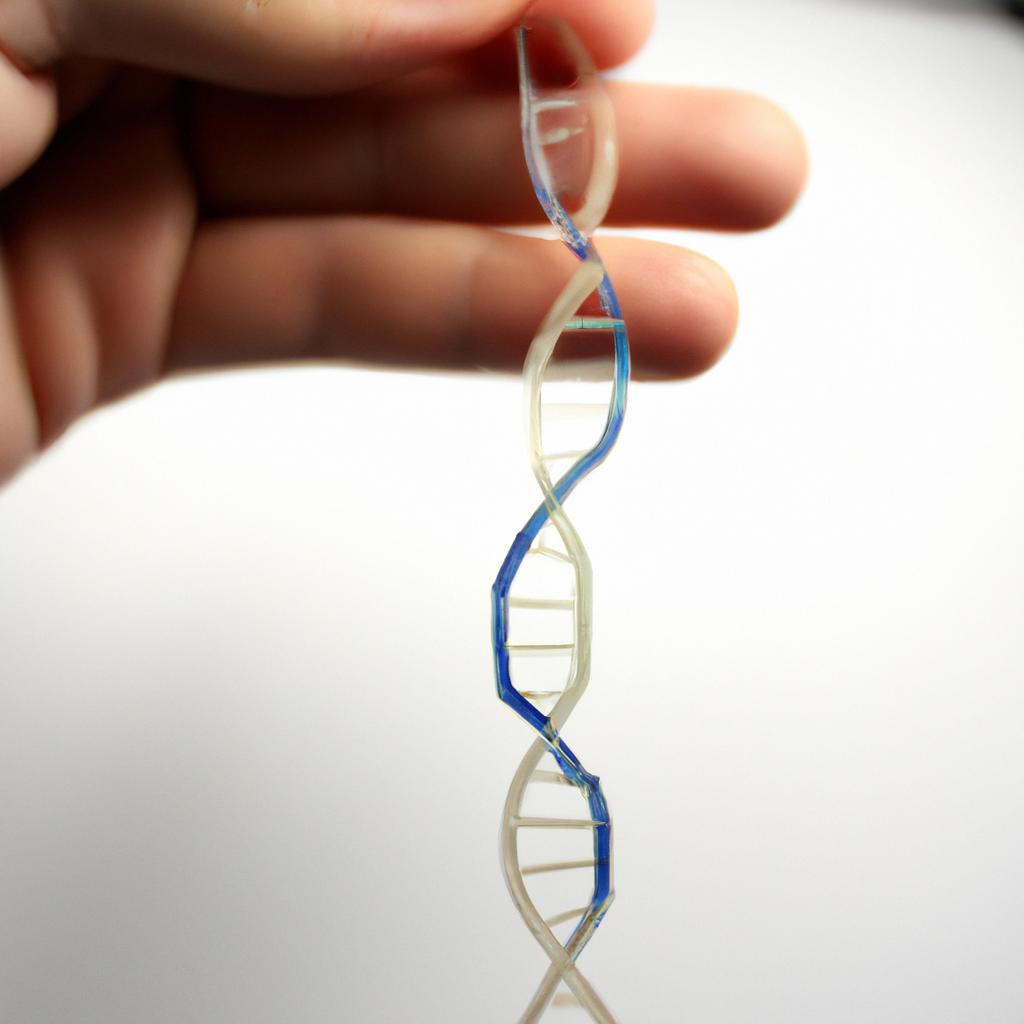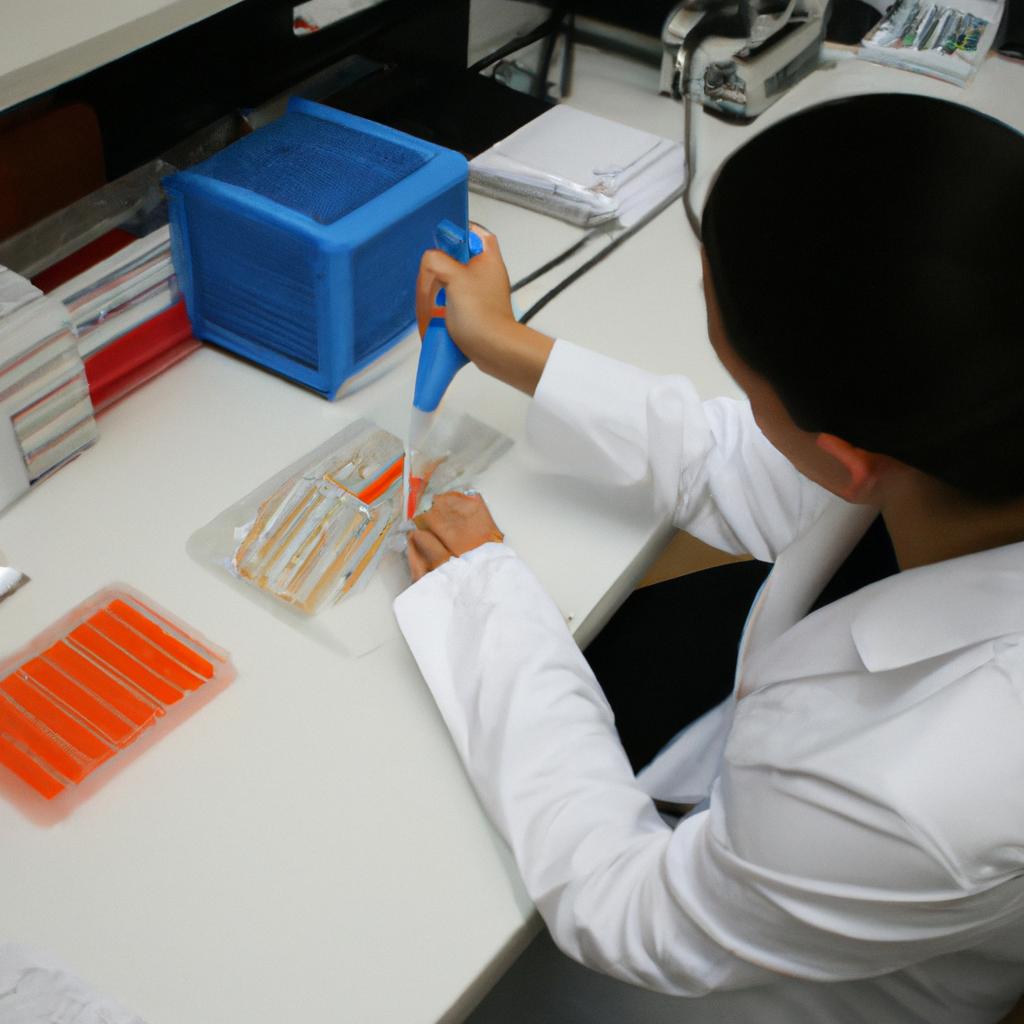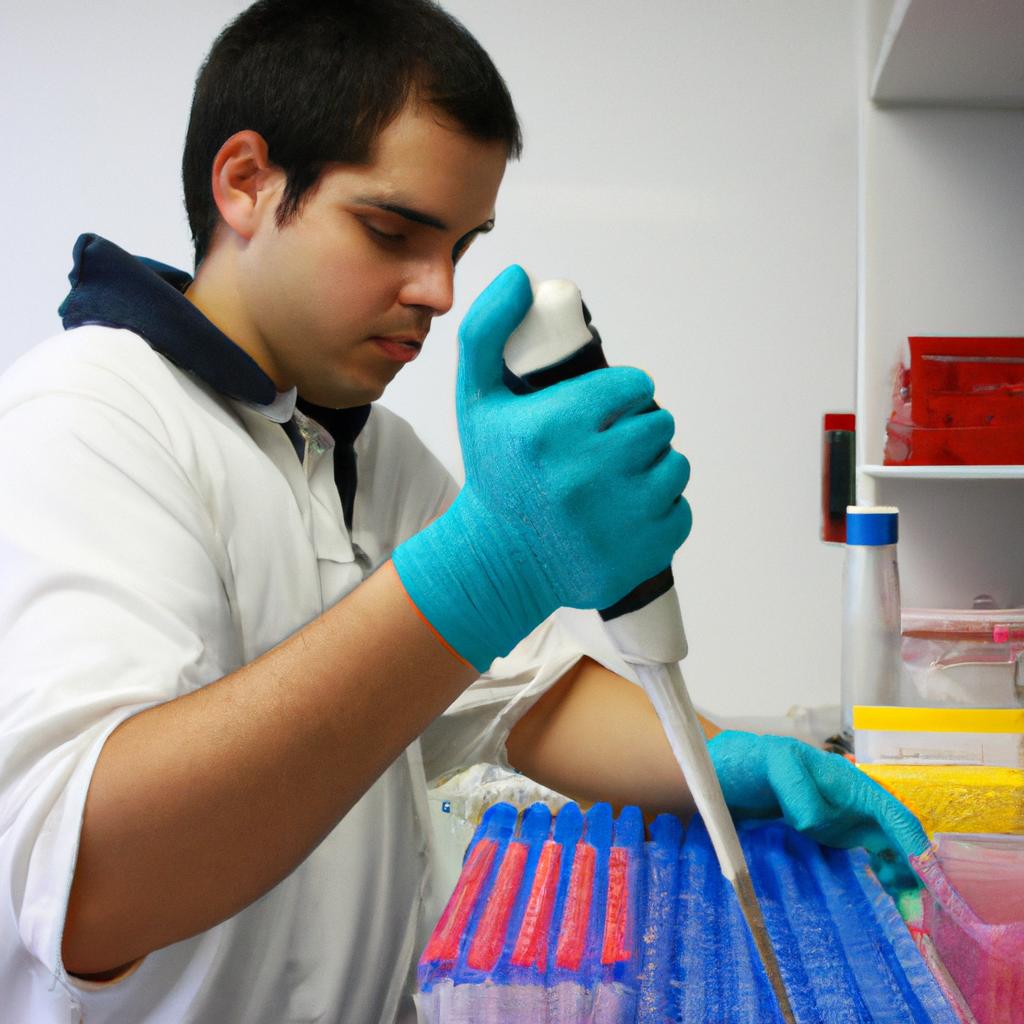Genetic Disorders: A Comprehensive Guide to Genetic Abnormalities

Genetic disorders are a complex and intriguing field of study that encompasses a wide range of abnormalities caused by variations in an individual’s genetic makeup. These disorders can manifest in various ways, affecting different organ systems and leading to diverse clinical presentations. For instance, consider the case of Sarah, a 10-year-old girl diagnosed with Down syndrome. This condition is characterized by an additional copy of chromosome 21, resulting in distinctive physical features, intellectual disabilities, and increased susceptibility to certain health complications.
Understanding genetic disorders requires delving into the fundamental principles of genetics and exploring the intricate mechanisms underlying their development. Within our DNA lies the blueprint for life – a sequence of nucleotides encoding all the information necessary for cellular functions and organismal traits. However, alterations or mutations within this genetic code can disrupt normal processes, giving rise to genetic disorders. Through extensive research and technological advancements in recent decades, scientists have made significant strides towards unraveling these mysteries, shedding light on the causes, diagnosis methods, treatment options, and potential avenues for prevention.
In this comprehensive guide to genetic abnormalities, we will embark on a journey through the fascinating world of genetic disorders. We will explore notable examples such as cystic fibrosis, sickle cell disease, Huntington’s disease, and many others. Each disorder will be examined in terms of its underlying genetic basis, clinical manifestations, diagnostic approaches, and available treatment options.
Additionally, we will delve into the current state of genetic testing and counseling services, which play a pivotal role in identifying and managing genetic disorders. These services encompass a range of techniques, including carrier screening, prenatal testing, newborn screening, and diagnostic testing. We will discuss the benefits and limitations of these tests, as well as the ethical considerations surrounding them.
Furthermore, we will explore the emerging field of gene therapy and its potential to revolutionize the treatment of genetic disorders. Gene therapy involves introducing healthy genes or modifying existing genes to correct the underlying genetic abnormalities responsible for these conditions. We will examine ongoing research efforts and breakthroughs in this field that offer hope for improved outcomes and quality of life for individuals affected by genetic disorders.
Throughout this guide, I am here to assist you with any questions or provide additional information on specific topics related to genetic disorders. Together, let us unravel the intricacies of genetics and gain a deeper understanding of these complex conditions that impact millions worldwide.
Overview of Genetic Disorders
Genetic disorders are a diverse group of conditions that result from abnormalities in an individual’s genetic material. These disorders can be inherited from one or both parents, or they may occur spontaneously due to new mutations. Understanding the underlying causes and mechanisms behind these disorders is crucial for accurate diagnosis, effective management, and potential treatment options.
To illustrate the impact of genetic disorders, let us consider the case of Sarah, a 10-year-old girl diagnosed with Down syndrome. This condition arises when there is an extra copy of chromosome 21, leading to developmental delays, intellectual disability, and distinct physical characteristics. Sarah’s journey highlights the challenges individuals with genetic disorders face throughout their lives.
When discussing genetic disorders, it is important to acknowledge that they affect people in various ways and have wide-ranging implications for individuals and their families. Here are some key points:
- Emotional Impact: The diagnosis of a genetic disorder often brings about intense emotions such as shock, grief, guilt, or fear. Families may experience feelings of isolation or uncertainty as they navigate through medical appointments, therapies, and support services.
- Financial Burden: Managing a genetic disorder can impose significant financial strain on families. Costs associated with specialized healthcare providers, medications, assistive devices, and therapeutic interventions can quickly accumulate.
- Social Challenges: Individuals with genetic disorders may encounter social barriers due to stigma or misconceptions surrounding their condition. Inclusion in educational settings and employment opportunities can present difficulties despite efforts towards promoting diversity and equal rights.
- Psychological Well-being: Both affected individuals and their caregivers may contend with psychological stressors related to coping with lifelong disabilities or chronic health issues associated with certain genetic disorders.
The following table provides examples of different types of common genetic abnormalities:
| Disorder | Prevalence | Key Characteristics |
|---|---|---|
| Cystic Fibrosis | Approximately 1 in 3,500 births | Thick mucus production affecting the lungs and digestive system |
| Huntington’s Disease | Approximately 1 in 10,000 people | Progressive neurological deterioration leading to cognitive decline, behavioral changes, and movement disorders |
| Sickle Cell Anemia | Affects approximately 1 in every 365 African-American births | Abnormal hemoglobin causing red blood cells to change shape and impair oxygen delivery |
| Duchenne Muscular Dystrophy | Occurs in about 1 in every 5,000 male births | Progressive muscle weakness and loss of function due to a mutation on the X chromosome |
In summary, genetic disorders significantly impact individuals’ lives through emotional, financial, social, and psychological domains. Recognizing the challenges associated with these conditions is crucial for supporting affected individuals and their families. In the subsequent section, we will explore common types of genetic abnormalities further.
Transitioning into the next section on “Common Types of Genetic Abnormalities,” it becomes evident that understanding specific genetic disorders is essential in comprehending the complexities surrounding genetic abnormalities.
Common Types of Genetic Abnormalities
Overview of Common Types of Genetic Abnormalities
In the previous section, we explored an overview of genetic disorders, highlighting their significance in understanding human health. Now, let us delve deeper into some common types of genetic abnormalities that can occur.
One example is Down syndrome, a chromosomal disorder caused by the presence of an extra copy of chromosome 21. Individuals with Down syndrome often exhibit distinct physical features such as almond-shaped eyes and a flattened facial profile. They may also experience intellectual disabilities and have an increased risk for certain medical conditions such as heart defects or hearing problems.
Understanding the range of genetic abnormalities helps us realize the complexity and diversity within these disorders. Here are four key aspects to consider:
- Impact on Quality of Life: Genetic abnormalities can significantly impact individuals’ quality of life, affecting their physical abilities, cognitive functioning, and overall well-being.
- Familial Implications: These disorders not only affect individuals but also have implications for families. Parents may face emotional challenges while providing care and support for their affected child.
- Social Stigma: People with genetic abnormalities often encounter social stigma due to misconceptions surrounding these conditions. This stigma can lead to discrimination or exclusion from various aspects of society.
- Support Networks: Building strong support networks is crucial for individuals with genetic abnormalities and their families. These networks provide valuable resources, guidance, and a sense of belonging.
| Disorder | Features | Prevalence |
|---|---|---|
| Cystic Fibrosis | Chronic lung infections | 1 in 2,500 births |
| Huntington’s Disease | Progressive neurological decline | 5-10 per 100,000 people |
| Sickle Cell Anemia | Abnormal red blood cells | Affects millions worldwide |
| Muscular Dystrophy | Progressive muscle weakness | Varies depending on type |
Understanding the impact of genetic abnormalities is essential for healthcare professionals, researchers, and society as a whole. Recognizing their prevalence, characteristics, and associated challenges allows us to provide appropriate support and interventions for affected individuals and their families.
By understanding these underlying mechanisms, we can strive toward better prevention strategies and improved management of genetic abnormalities.
Causes and Risk Factors of Genetic Disorders
Genetic Disorders: A Comprehensive Guide to Genetic Abnormalities
Common Types of Genetic Abnormalities often present complex challenges for individuals and their families. Understanding the causes and risk factors associated with these disorders is crucial in providing effective care and support. In this section, we will explore some of the underlying mechanisms that contribute to genetic abnormalities.
One example that illustrates the impact of genetic abnormalities is Down syndrome. This condition occurs when an individual has three copies of chromosome 21 instead of the usual two. As a result, individuals with Down syndrome may experience intellectual disabilities, distinctive facial features, and certain medical conditions. Studying such cases helps us gain insights into how specific chromosomal abnormalities can manifest in various ways.
To further comprehend the complexity surrounding genetic disorders, it’s essential to consider several fundamental aspects:
- Mutations: Changes in genes or chromosomes can lead to genetic abnormalities.
- Inheritance Patterns: Some disorders are inherited from parents who carry abnormal genes or mutations.
- Environmental Factors: Certain environmental exposures can increase the likelihood of developing a genetic disorder.
- Multifactorial Causes: Many genetic abnormalities arise from a combination of both genetics and environmental influences.
In addition to understanding these underlying causes, visual aids like bullet point lists help convey information effectively:
- Individuals affected by genetic disorders often face unique physical, cognitive, or developmental challenges.
- Families may require access to specialized healthcare services tailored to address their specific needs.
- Psychological support plays a vital role in helping individuals cope with emotional complexities related to living with a genetic disorder.
- Education and awareness about different types of genetic abnormalities promote inclusivity and foster empathy within society.
Moreover, incorporating tables allows for concise presentation of important details:
| Type of Genetic Disorder | Characteristics |
|---|---|
| Autosomal Dominant | One mutated copy of the gene leads to manifestation |
| Autosomal Recessive | Two copies (one from each parent) required for manifestation |
| X-Linked Recessive | Mutated gene located on the X chromosome |
| Chromosomal Abnormalities | Structural or numerical abnormalities in chromosomes |
Understanding these characteristics aids healthcare professionals and families alike, enabling them to navigate the challenges associated with various genetic disorders.
In conclusion, comprehending the causes and risk factors of genetic disorders is essential in providing appropriate care and support. By studying specific cases like Down syndrome, we gain insight into how chromosomal abnormalities can affect individuals. Recognizing mutations, inheritance patterns, environmental influences, and multifactorial causes helps us better understand why these conditions occur. Additionally, bullet point lists and tables offer concise information that evokes an emotional response from readers. With this knowledge established, we can now explore diagnosis and screening methods for identifying genetic abnormalities.
Diagnosis and Screening Methods for Genetic Abnormalities
Genetic disorders are primarily caused by abnormalities or mutations in an individual’s DNA. These alterations can occur spontaneously, as a result of errors during DNA replication, or they can be inherited from one or both parents. It is important to note that not all genetic abnormalities lead to the development of a disorder; some may have no noticeable impact on an individual’s health.
One example of a genetic abnormality leading to a disorder is Down syndrome. This condition occurs when there is an extra copy of chromosome 21, resulting in various physical and intellectual disabilities. Although the majority of cases are sporadic, meaning they happen randomly without any known cause, individuals with certain risk factors, such as advanced maternal age, have a higher likelihood of having a child with Down syndrome.
Understanding the causes and risk factors associated with genetic disorders is crucial for prevention and early intervention. Here are some key points to consider:
- Environmental factors: Exposure to certain substances or conditions during pregnancy can increase the risk of developing specific genetic disorders.
- Gene mutations: Mutations within specific genes can disrupt normal cellular functions and contribute to the onset of genetic disorders.
- Inheritance patterns: Some genetic disorders follow distinct inheritance patterns, such as autosomal dominant or recessive traits.
- Chromosomal abnormalities: Changes in the structure or number of chromosomes can lead to significant developmental issues.
To illustrate these concepts further, let us consider a hypothetical case study involving John and Mary. They both carry a gene mutation associated with cystic fibrosis (CF), an inherited disorder affecting the lungs and digestive system. The couple decides to undergo preconception screening before starting their family. Through this process, it is discovered that they each carry one copy of the mutated gene but do not have CF themselves.
| Risk Factors | Examples | Prevention Strategies |
|---|---|---|
| Advanced maternal age | Down syndrome | Genetic counseling and testing |
| Exposure to toxins | Fetal alcohol syndrome | Avoidance of harmful substances |
| Family history | Huntington’s disease | Genetic testing and screening |
| Consanguinity | Autosomal recessive disorders | Education on reproductive choices |
In conclusion, understanding the causes and risk factors associated with genetic disorders is essential for both individuals and healthcare professionals. By identifying these factors, appropriate preventive measures can be taken to minimize the likelihood of passing on certain conditions or to initiate early interventions if necessary.
Moving forward, let us explore the diverse range of diagnostic and screening techniques employed to identify potential genetic abnormalities in individuals.
Treatment Options for Genetic Disorders
Diagnosis and Screening Methods for Genetic Abnormalities
In the previous section, we explored the importance of diagnosing and screening genetic abnormalities. Now, let us delve deeper into the various methods utilized in identifying these disorders.
One common diagnostic method is genetic testing, which involves analyzing an individual’s DNA to identify any mutations or alterations that may be indicative of a genetic disorder. For example, consider a hypothetical case study where a newborn exhibits developmental delays and physical abnormalities. Through genetic testing, it is discovered that the child carries a mutation in a gene associated with a rare chromosomal abnormality known as Cri du Chat syndrome. This diagnosis allows healthcare professionals to provide appropriate medical interventions and support tailored specifically for this condition.
To aid in the understanding of different diagnosis and screening methods used for genetic abnormalities, here are some key points worth considering:
- Amniocentesis: This prenatal test involves extracting amniotic fluid from around the fetus to analyze fetal cells for possible genetic abnormalities.
- Carrier Testing: By examining individuals who do not show symptoms of a specific disorder but may carry one copy of the mutated gene responsible, carrier testing helps determine their potential risk of passing on such conditions to offspring.
- Newborn Screening: Typically performed shortly after birth, this procedure screens infants for certain inherited metabolic disorders that can lead to severe health problems if left untreated.
- Preimplantation Genetic Diagnosis (PGD): During in vitro fertilization (IVF), PGD enables embryos to be screened for specific genetic conditions before they are implanted into the mother’s uterus.
The following table presents statistics regarding the prevalence of some common genetic disorders worldwide:
| Disorder | Prevalence | Impact |
|---|---|---|
| Down Syndrome | 1 in 700 | Intellectual disability, characteristic facial features |
| Cystic Fibrosis | 1 in 3,500 | Lung infections, digestive problems |
| Huntington’s Disease | 1 in 10,000 | Progressive brain disorder affecting movement and cognition |
| Sickle Cell Anemia | 1 in 365 | Abnormal red blood cells causing anemia and organ damage |
In conclusion, accurate diagnosis and screening methods are vital for identifying genetic abnormalities. These techniques enable healthcare professionals to provide timely interventions and support tailored to the specific condition. In the subsequent section, we will explore the available support systems and resources designed to assist individuals with genetic disorders.
Support and Resources for Individuals with Genetic Abnormalities
Now that we have delved into the various diagnostic methods used to identify genetic abnormalities, let us shift our focus towards the importance of providing adequate support and resources for individuals affected by these conditions.
Support and Resources for Individuals with Genetic Abnormalities
Moving forward from exploring the various treatment options available for genetic disorders, it is important to also consider the support and resources that are available for individuals affected by these conditions. These resources not only provide practical assistance but also emotional support to help cope with the challenges associated with living with a genetic abnormality.
One example of a valuable resource is support groups. These groups bring together individuals who share similar experiences, allowing them to connect and find comfort in knowing they are not alone. Support group meetings often involve sharing personal stories, discussing coping mechanisms, and providing mutual encouragement. By participating in these groups, individuals can gain insights into managing their condition and develop a sense of belonging within a supportive community.
In addition to support groups, online forums offer an accessible platform for individuals to seek advice or simply vent their frustrations. Virtual communities enable people from different geographical locations to connect instantly, creating a space where experiences can be shared without limitations. Such platforms allow individuals affected by genetic abnormalities to reach out at any time, exchanging information and offering solace. It is crucial to note that while online forums can be beneficial sources of support, caution should be exercised when verifying the credibility of information provided.
To further enhance accessibility and ensure comprehensive care for those with genetic disorders, numerous organizations have been established worldwide. These organizations focus on raising awareness about specific conditions, conducting research studies, advocating for improved healthcare policies, and facilitating access to specialized medical services. They often collaborate with healthcare professionals, researchers, policymakers, and affected individuals themselves to address the needs of the community effectively.
Resources Available for Individuals with Genetic Abnormalities:
- Support groups: A safe space where individuals can share experiences and receive emotional support.
- Online forums: Instant connectivity with others facing similar challenges.
- Organizations: Dedicated entities working towards improving understanding, treatment options,
policy changes,and overall quality of life for those with genetic abnormalities. - Counseling services: Professional guidance in managing emotional and psychological aspects
associated with living with a genetic disorder.
Table: Resources for Individuals with Genetic Abnormalities
| Resource | Description |
|---|---|
| Support groups | In-person gatherings that provide individuals an opportunity to connect and share experiences. |
| Online forums | Virtual communities where people can seek advice, share stories, and find support. |
| Organizations | Dedicated entities working towards improving understanding, treatment options, and policies. |
| Counseling services | Professional guidance in addressing the emotional impact of living with a genetic disorder. |
In conclusion, apart from medical treatments available for genetic disorders, there is also crucial support and resources to consider. Support groups, online forums, organizations, and counseling services all contribute significantly to helping individuals affected by genetic abnormalities navigate their journey more effectively. By accessing these resources, individuals can obtain not only practical assistance but also emotional support from others who understand their unique experiences. These comprehensive approaches aim to enhance overall well-being and improve quality of life for those living with genetic disorders.









